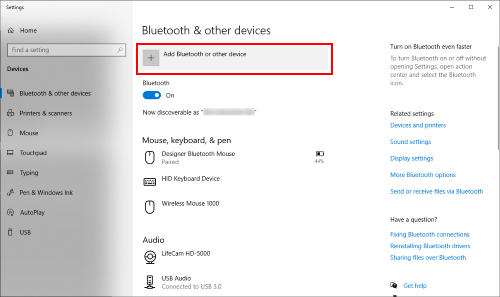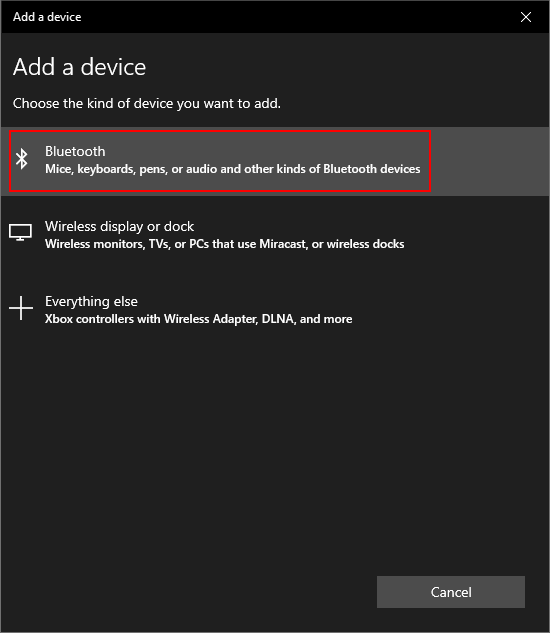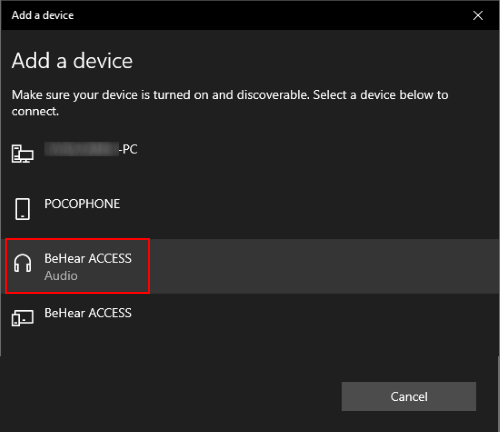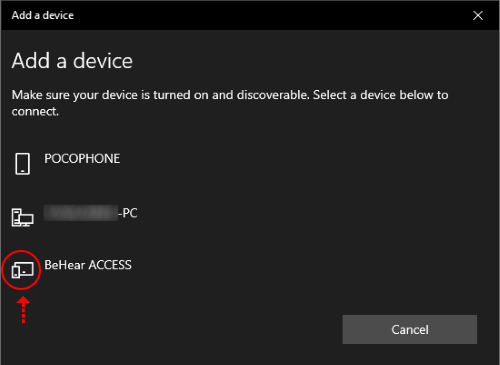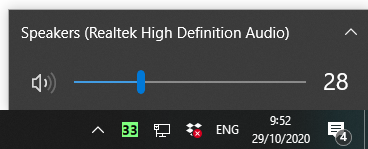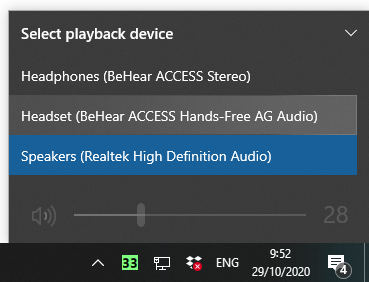Can I use my own headset with SMARTO?
Even though SMARTO has a standard audio jack that can accommodate third party headphones, we highly recommend using one of the two headsets that are supplied with SMARTO (in-ear or on-ear). This is because these headsets:
- include a high-quality microphone, which works in tandem with the two microphones in the SMARTO device to clarify what is heard and eliminate unnecessary sounds.
- have been optimized to work with BeHear sound enhancement algorithms (based on their specifications).
If you do choose to use a third party headset with SMARTO make sure that it comes with a built-in microphone.
Is it possible for others to hear the TV while I am using my BeHear headset?
This depends on how you are using your BeHear ACCESS, and your specific TV.
- If you are using BeHear in Personal Hearing mode to amplify nearby important sounds, others will be able to hear the TV as well.
- If you are using BeHear as a Bluetooth receiver, paired with your television, others will probably not be able to hear the TV. However, if your television (or set top box) supports simultaneous sound output to optic/RCA/3.5mm and the TV speakers, we have a recommendation for a workaround (see below).
If your television doesn’t support Bluetooth, or if it doesn’t support dual audio output when a Bluetooth device is connected, we recommend using a Bluetooth transmitter, such as our HearLink PLUS, to enable the television audio to be transmitted to both your BeHear headset and the TV speakers.
In any event, you should check your television manual for information about Bluetooth connections and dual audio output.
How do I adjust the volume of the voice prompts, or mute them completely?
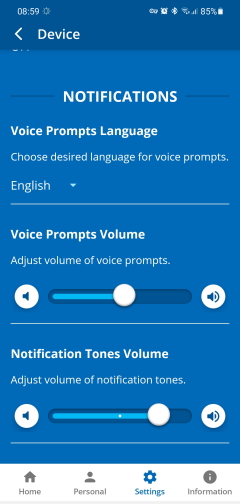
- Make sure to download the W&H BeHear app and pair it with your headset.
- In the app, tap the “Settings” menu at the bottom of the screen.
- Tap the “Device” icon.
- Scroll down to reach the “Notifications” section (see attached image).
- You can regulate the volume of the voice prompts using the slider (increase to the right, decrease to the left) or mute the prompts completely by moving the dot all the way to the left, until the speaker icon is “grayed out”.
The sound is distorted in my BeHear headset.
If you are experiencing sound distortion while multiple Bluetooth devices are connected to your BeHear headset, we recommend that you modify the default CODEC (APTX LL) and choose either the APTX or SBC CODEC instead.
This can be done in the W&H BeHear app, while your headset is paired and connected to your smartphone.
- Go to the Settings menu.
- Choose Device.
- Scroll down to the “ADVANCED” section and choose the desired CODEC from the dropdown list.
Note: You will need to turn your headset off and then back on to apply the modification.
How do I know if a firmware update is available for my headset?
When your headset is connected to the Internet (via the Bluetooth connection to your mobile phone or a computer), you can get notification of the availability of an update (and then apply it to your headset). The W&H BeHear app checks for updates automatically when the Auto option is selected for the Headset Update Check in the Application section of the Settings screen. You can also check manually by choosing the Settings option from the bottom menu of the app and then tapping the Update button on the screen.
Can I use the BeHear to listen to the TV without the HearLink PLUS?
You can use the BeHear headset to listen to the TV even without the HearLink PLUS transmitter, but HearLink PLUS will provide better sound quality, as the audio will be streamed directly to the headset.
How do I pair the headset to my Windows Desktop PC?
- To connect your BeHear headset to a Windows PC desktop computer, first you must place the headset into pairing mode (when the headset is OFF, press the power button for several seconds until the LED flashes alternating red and blue lights).
- Then (and only then!) go to Settings > Bluetooth & other devices on your Windows PC.
- Click the “Add Bluetooth or other device” option
- Click “Bluetooth”:
- Your BeHear headset will appear as an audio device in the list next to a “headphone” icon. Click on this device name to connect:
Note: If you don’t follow the sequence detailed above, and instead start searching for new device in the PC while your headset is simply ON (not in pairing mode), BeHear will appear in the list as unknown device, with no “audio” under the name and no “headphone” icon next to it. Connecting to this device will not activate BeHear as a headphone/headset.
Can I leave the battery to charge overnight?
Yes, although you can fully charge the headset’s battery within 2-3 hours, it is not damaging to the battery to keep it in the charger overnight.
Will these headsets help me to hear better in conference calls such as MS Teams, Zoom, Skype, and WebEx?
Yes, our assistive hearing headsets are designed to give you personalized amplification for computer-generated audio and conference calls, as well as live conversations.
For conference calls with apps such as Skype, Zoom, MS Teams, Google Meet, and WebEx, you will simply need to pair the BeHear headset with the sound source (smartphone or computer) and select BeHear in the conference platform’s audio settings.
I hear a whistling noise coming from the headset.
This noise, which sounds like a whistle and is also known as feedback, can be the result of one or more issues. There are a few things you can do:
- The ear bud may not be securely positioned within the ear canal. Try to re-adjust it, or choose a pair of ear tips that fit better. See one of these videos for details:
BeHear ACCESS
BeHear NOW - The volume may be too high. Try turning it down a bit.
- Change the “Best Sound Point” in the Sound Tuning grid to a lower region on the screen.
See one of these videos for details:
BeHear ACCESS
BeHear NOW - Severe hearing loss in the high frequencies, which necessitates a high amount of amplification for these frequencies, may be responsible for the whistling. If this is the case, contact our tech support group with a screen shot of your Hearing Assessment results. They may be able to adjust some of the values to improve the situation.
- If none of the above solves the problem, you may have wax build-up in your ear.
My BeHear headset is paired to the computer but the audio is coming out of the speakers, not the headset.
- As the headset can be connected to two devices at any one time, you need to make sure it’s not currently channeling the audio from any other device you may have connected (iPad/tablet/HearLink, etc.)
- In order to make sure your headset is connected to the computer, double-click the speaker icon on the Windows lower menu bar.
The name that appears should be “BeHear” and not “Speakers”. If you see the name “Speakers” click the ^ (arrow). If the BeHear is connected properly you will be able to see it listed under the list of playback devices. Choose the “Headset” option. - When connecting to a desktop / Windows computer, the BeHear headset can appear in two different listings, once as a “Headset” and once as “Headphones”.
- Only the “Headset” listing will enable the BeHear microphones to transmit (the “HeadPhones” setting uses BeHear as a speaker only). Try switching between these two options.
- If you are using a communication application, such as Skype or Zoom, it is not enough to specify in the computer settings that the BeHear headset should be the audio device. You will also need to specify it in the communication application’s audio settings.
HearLink PLUS isn’t working right when two headsets are paired with it.
Check these possible causes :
- One of the headsets is out of range. The quality of the Bluetooth connection (and associated audio distortions) depends on the weakest connection of the two connected headsets. For example, audio distortions may be heard by the wearer of the headset closest to the HearLink/HearLink PLUS transmitter when the second headset is out of the transmitter’s range.
- One of the headsets is not a BeHear headset. The active CODEC (SBC, aptX or aptX-LL) for the HearLink PLUS transmitter is determined according to the common denominator for the both headsets. Two BeHear headsets will always operate in aptX-LL mode. However, if one of the connected headsets is not a BeHear headset, and it doesn’t support aptX, both headsets will work in the lower quality SBC mode only.
- Each headset is paired to a different mobile phone. It is not recommended to connect two headsets simultaneously to one HearLink PLUS and maintain separate smartphone connections for each headset. This is due to problems which may arise when the wearer desires to switch the audio stream between his/her phone and HearLink PLUS (e.g., for an incoming call from one of the phones).
Is there a way to adjust volume on left or right individually without editing a hearing profile?
The answer is yes. When you are in Personal Hearing mode, tap the equalizer button under the hearing environment icons. Scroll down until you reach the “Balance” section. You can adjust the balance between ears here, and it will apply to all hearing environments (Indoor, Outdoor, Crowd, and Live Music) as well as the hearing modes (Personal Hearing, Mobile Calls, and Audio Streaming).
You may find this setting useful for situations in which annoying sounds are coming from a specific direction, and you are unable to change your physical position. Otherwise, there may be no need, since once you have applied the results from your hearing assessment to the headset the balance should then be optimal for your unique hearing profile.
Can I use my BeHear headset to hear audio from my laptop computer?
Yes, absolutely!
Depending on the application, BeHear may appear either as a headset or as a headphone, just like most other Bluetooth headphones.
For most music players it will be listed as a “headphone” while for messaging services, such as Skype/Viber/WeChat etc., it will be listed as a “headset”.
Is the headset battery replaceable?
The battery in the BeHear headset is rechargeable (tested up to 600 cycles) but not replaceable. We designed it this way to provide protection against water and dust damage for the life of the product, as well as to keep the cost to the consumer low.
Where does the BeHear headset appear in the Bluetooth device’s pairing screen?
Depending on the application, BeHear may appear either as a headset or as a headphone, just like most other Bluetooth headphones.
For most music players it will be listed as a “headphone” while for messaging services, such as Skype/Viber/WeChat etc., it will be listed as a “headset”.
